Table of Contents
Close
What You'll Learn:
- How to convert revenue growth targets into sales & marketing KPIs.
- How customers have evolved and the implications for MSP sales and marketing lead generation strategies.
- What's required for MSP appointment setting to succeed and how to gather intel on your target market.
- How to differentiate your IT managed services firm by insourcing content creation.
Who This Guide Is for:
- You’re President or CEO of an MSP and you need a consistent pipeline of warm leads for your managed or co-managed IT services. Your referral pipeline is dry and other MSP lead generation services have resulted in nada.
- You’re VP of Sales for a medium-sized MSP overseeing a small team of Sales Development Reps (SDRs) and you need a more predictable MSP lead generation solution. The appointments are fewer and the close-rate is not high enough to achieve revenue targets.
- You’re the Marketing Director for an MSP and are wondering why traction is so difficult. The problem isn’t “you,” it’s the lead generation system that needs a serious revamp.
Ready? Scroll Down to Start Reading!
About the Author

Derek Marin, President of Simple Selling
Simple Selling does business development and marketing for MSPs that have better things to do.
Our process turns cold prospects into warm opportunities for managed and co-managed services agreements.
Table of contents
Click on any chapter to scroll directly to it.
Chapter 1
Revenue Goal Settings
Goal-setting is important? Absolutely, come on, you already knew that. But surprisingly few MSPs write down revenue goals.
Why would writing your goal down help make it actually happen?
Well, let's consider how goals affect a marathoner.
A marathon is 26.2 miles. It’s long and takes discipline to complete. Not so different from the journey for growing an MSP MRR.
Do we have 3 months or 12 to train? A major detail for a runner. Not so different for a growth plan. Stating the timeline aloud is important for every person involved in sales and marketing.
If a marathoner aims to finish in under 3.5 hours because qualifying for the Boston Marathon demands it, then that is a very fast pace and it would affect the plan significantly. Similarly, if you want your MSP to receive an attractive valuation for M&A, that would imply certain traction in organic growth and affect the plan, too.
Okay, I think the marathon analogy has reached it's limit so let's move on, shall we?
How to Set Sales Goals
Okay, so here’s a short series of questions to arrive at a sales goal for your MSP.
By how much do you want annual revenue to grow for your MSP in 3 years?
For example, maybe in 3 years you want to grow MRR by $2,000,000 or maybe $1,000,000 is more achievable given sales today.
Your goals are your goals. There is no right or wrong.
Next, let’s reverse engineer revenue targets into sales and marketing KPIs.
What percentage of that revenue growth do you expect from new customers vs existing customers?
For example, if your growth goal is $1,000,000 in 3 years and 75% is expected from new customers, then 75% x $1,000,000 = $750,000 is what represents your sales goal from new business and $250,000 is from upgrading existing customers.
How many new customers do you need in order to achieve your sales goal?
For example, take the $750,000 and divide by the average annual revenue per new client. Below we’ll assume that a new client brings in $30,000 in annual revenue.
$750,000 ÷ $30,000 = 25 new clients are necessary to achieve your goal in 3 years.
How many opportunities do you need in order to close enough new customers?
Let's be clear about what an “opportunity” means.
An Opportunity is a lead that meets your criteria in terms of industry, headcount range, location, and willingness to step into your sales process; in other words, they go further than an initial appointment and agree to an assessment of some kind.
So to calculate the number of opportunities we need to estimate your average closed-won ratio.
And what exactly s the closed-won ratio?
It refers to the average percentage of Opportunities (Opps) that convert into a new customer.
On many occasions I’ve heard MSP Presidents claim, “I close 80% of the time!”
In my experience, they are thinking about referrals, which are different from marketing-sourced opportunities in significant ways.
Look at the photo below of the wide open soccer net. My 1 year old couldn’t miss that. And MSPs shouldn’t miss on referrals, either. Even a technical owner with little to no experience in sales can score with referrals most of the time.
But why are referrals like an open net shot? Because of trust. A friend, peer or colleague recommended you and therefore they believe your services are dependable. Your sales skills? They don’t matter a whole lot here.

On the other hand, opportunities from a salesperson or an MSP lead generation services vendor are different. Think about it. The prospect may have received a cold-call just when they decided to start shopping for a different MSP. You won’t be the only one they meet with. Sales skills will play a larger role in this case.
Quick story.
I was talking to the President of an MSP that’s based out in California, and he shared a story about one of his customers.
One of his friends owns a company and that friend became a customer of his. One day that friend received a cold-call from a different MSP offering a free IT assessment.
Even though the friend was a happy customer, he agreed to the assessment anyway. He never intended to switch MSPs, but he figured it would not hurt to compare and validate what his current MSP was doing.
The assessment found some areas to improve (those reds and yellows!) and so those gaps were eventually fixed by the incumbent MSP.
The point?
Some appointments aren’t quite Opportunities. At least not right away. They have a motive for meeting you but it doesn’t always mean they are in a buying cycle now.
Okay, so let’s assume that the close-rate for marketing-sourced leads will be lower than what it is for warm referrals.
For example, if you assume your closed-won ratio for warm referrals is 50% then maybe a closing ratio of 20% for marketing-sourced leads is fair.
Therefore, here’s how you can use that 20% conversion to calculate the Opportunities you need.
25 new clients ÷ 20% close rate = Number of Opps you would need over the next 3 years!
In this example you would need 125 Opportunities over the next 3 years in order to achieve your sales goals.

Featured Article on www.SmarterMSP.com
Why is MSP Lead Generation Services so Challenging?
Chapter 2
Distinguishing your MSPs Message
This chapter was written in 2023 and much of it still stands. However, to find the 2024 updates, scroll down to '2024 updates.'
Is your MSP “proactive”?
Are you a special “Microsoft certified partner”?
Do you offer “Cloud Solutions” and “Back-up and disaster recovery”?
Yes, yes and duh!
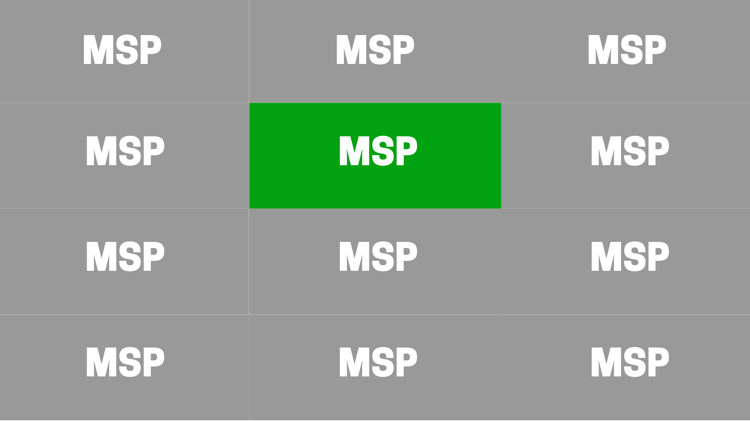
So how can an MSP separate from the pack when we’re selling mostly same things?
That's the million dollar question right there.
Well, before we start doing anything different, let's start by quitting the bad stuff. That's right. The first step on the differentiation path is to STOP doing what most MSPs are doing.
- I shall not copy direct competitors’ marketing
- I shall not emphasize “Great IT Support”
- I shall not emphasize “Lots of experience”
- I shall not emphasize “The best people”
- I shall not used words like “We are the most proactive”
- I shall not emphasize “We have values and principles”
- I shall not pour most marketing resources into more “tech tip” content
Do not misinterpret. Of course there is a place for talking about your experience, people and core values. But not at first. They aren’t wowing your prospects – they just interpret that as sales mumbo jumbo.
When we focus on “tech tips” we sound boring and like the incumbent MSP.
Okay, so what now?
The answers are coming.
Please read on or watch this webinar.
The MSP Divide
We all know the MSP industry has been around a long time. According to ChannelE2E there are 20,000 in the North America alone. That’s a lot. It’s probably closer to double this amount by now.
And MSP-specific technology has advanced significantly, too.
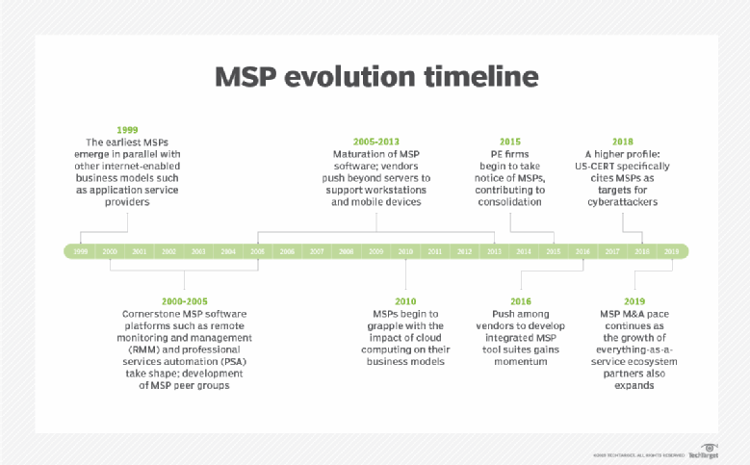
According to TechTarget’s timeline, MSP tools and platforms made big gains from 2005 onwards.
Despite these industry-wide advances, not every MSP has landed on two feet.
That's right. Some MSPs are stuck and you know EXACTLY what I'm talking about.
For example, stuck MSPs treat strategic business reviews as “nice to have” events with customers; they respond to customer problems in days instead of the same day; they skip hard cybersecurity conversations with customers because it’s uncomfortable; and internally they fail to “drink their own champagne” when it comes to policies, processes and documentation.
Stuck MSPs can be led by smart hardworking people. They can be doing a decent job in some areas for their customers. But, and this is a big but, their shortcomings are holding their own customers back.
On the other hand, some MSPs are led in a distinguished way. These companies are nimble and unlike the stuck MSPs, these managed service providers have evolved.
Evolved MSPs are obsessed with continuous improvement. They respond to customers quickly. They run structured strategic business reviews with customer's upper management. They offer best-in-class cybersecurity. Solutions are custom, not cookie-cutter, and they don't shy away from hard talks with customers, they embrace them because it makes impactful sh*t happen.
Pardon my french but I'm not going for polite here.
There’s now a big divide between many individual MSPs.
.png?width=750&height=422&name=Simple%20Selling%20Process%20(16).png)
None of this may be "breaking news" to you, but you're an insider. Of course YOU get this.
But prospects are out of the loop. They don't know what IT Nation is and they couldn't care less either.
For customers an "MSP is just an MSP."
And who's fault is this?
The damn marketer, that's who! That's right. Both internal marketers and vendors are to blame for customer indifference.
Fortunately, the solution is simple.
Marketing and sales has to step forward and be bold. We need to get un-stuck. It's not enough that MSP technology has improved business performance. It's not enough that cybersecurity solutions have leveled up. MSP marketing has to step up to the plate, too.
That's the "secret." Marketing won't work if it's the same playbook from 10 or 15 years ago.
The Customer Divide
The MSP evolution didn’t only impact MSPs, it also had a major impact on the customer experience. This is important for understanding the differentiation path.
Let’s analyze this customer shift by going back to the old buyer's journey from 15 years ago.
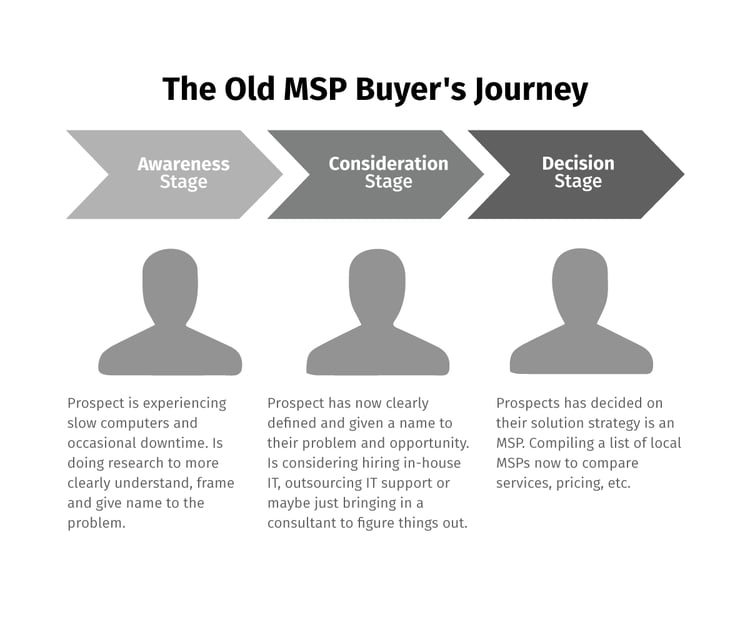
In the “Awareness stage” the customer wasn't a customer yet. They were a prospect. And they had symptoms of a larger IT problem.
“Slow computers.”
“Downtime!”
In the “Consideration stage” they define the problem as systemic and considered troubleshooting, called a break fix, and eventually, realized those weren’t the best value. So they advanced to the “Decision stage” where they compared MSPs and eventually signed an agreement.
Sales and marketing people responded to the Old MSP Buyer’s Journey by creating educational content.
Maybe we can call this Technology Tip Revolution chapter for the MSP history books.
For example, nearly every MSP website on the planet has these their own version of the following articles:
- “The top 5 benefits of managed services”
- “How to choose the right IT services provider”
- “Managed IT vs Break & Fix”
Not only did MSP “Tech Tip” marketing explode, the big channel vendors got in on the action as well. The TechTarget, Microsofts of the channel invested a massive amount into technology eBooks, guides and infographics all geared towards the small business owner.
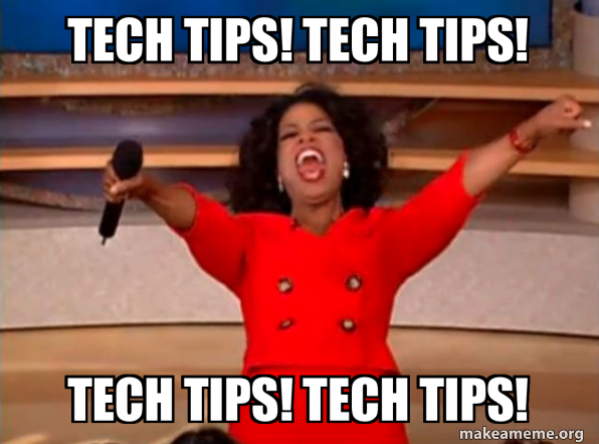
The New MSP Switcher’s Journey
Okay, so if we zoom to the present, how does the buyer’s journey look in 2022/2023?
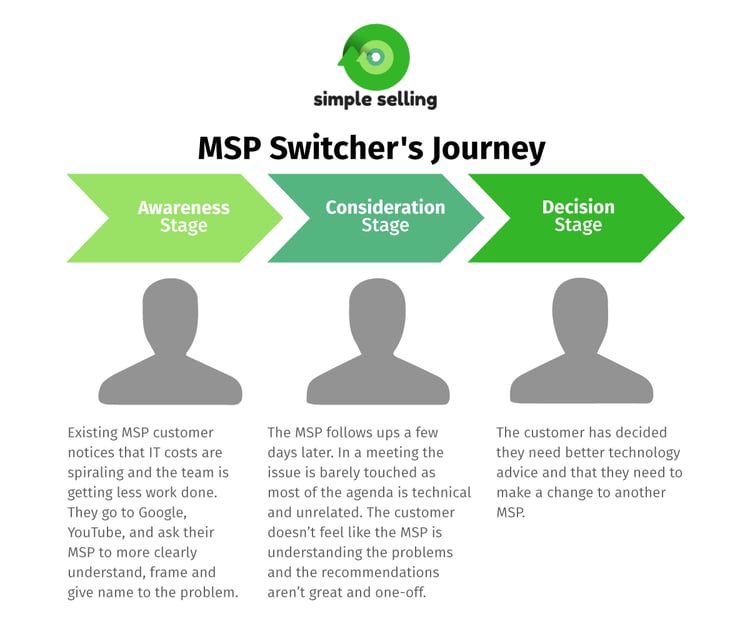
The first major difference between the old and new journeys is that most qualified MSP buyers are already partnered with an MSP!
The second difference is the types of problems customers have. Slow computers and downtime aren’t the main headaches any more. Instead it’s low productivity, inaccurate data in different systems, manual processes, poor adoption of expensive software, unused software, breaches, compliance, etc. The problems are not always technical. Sometimes it’s misalignment between technology, people and processes within the organization. Sometimes there are external factors, industry trends and misaligned customer expectations sprinkled into the mix.
Bottomline is that the problems are a serious pain in the ass, and remote agents and automation won’t fix these problems.
Regardless of root causes or the complexity, what matters is that these problems aren’t going away and this is driving a wedge between customers and incumbents.
2024 UPDATES
For most MSPs, 2022 was a boom and 2023 and 2024 have gone DOWN for new logo acquisition.
For our MSP clients, in 2023 especially, there were more proposals moving at a snail's pace then I've ever seen and it got all of us concerned.
However, in 2024 I attended an MSP event and breathed a big sigh of relief.
Even for a platform MSP like New Charter Technologies, that has over 36 locations nationwide and are buying smaller MSPs left and right, with their deep pockets, they admitted on stage in front of hundreds of your peers that acquiring new logos has been a rocky road because of longer "time to close" cycles, along with a general slow down in new leads from our usual sources.
So, does this mean organic growth is doomed for MSPs? Is it all about M&A now?
Nope, not necessarily.
Let's step back. Your industry is going through another major shift. Now we have disruptors like Electric.ai who are driving down pricing like Walmart did for retailers. And on top of that, there's inflation eroding profit margins and a new workforce of younger tech savvy end-users are becoming the majority, and they findi answers to common IT problems on their own, or with help from the web (YouTube, Knowledgebase, ChatGPT, etc.). All of these things are forcing MSP services to be more commoditized than ever before.
Dropping prices is not sustainable. Sure, you can cut some labor costs by outsourcing the SOC or maybe tier 1, that may help with margin, but it's not "the answer" to profitability and doesn't help with getting new logos. If we want a good valuation, EBITDA will need help from net new logos coming in, not just cutting costs.
So in the next few podcast episodes (I'm reviving the podcast!), we'll be talking to MSPs who are fixing the fundamental approach to organic growth.
Here's a hint. They're not approaching cold prospects with "do you want to switch IT providers? We got better service!"
▪ Instead, it's new solutions/offerings...
▪ It's getting their foot in the back door first and then taking over MSP services after...
Not all MSPs will agree, but my team believes it makes little sense to build an outbound motion that goes straight for managed IT on the first bite any more! That's a broken process that makes everyone cry and lose sleep because sales cycles are long and it's commoditized.
Instead, it's time to find the side doors, the ones your peers are ignoring that you can take advantage of. Think vCSO, compliance-as-a-service and co-managed IT as an ICP.
%20(1).png?width=750&height=422&name=Blog%20Green%20Bckgrnd%20imgs%20(1920%20%C3%97%201080%20px)%20(1).png)
Chapter 3
Connecting to Sales Qualified Leads
This chapter was written in 2023 and much of it still stands. However, to find the 2024 updates, scroll down to '2024 Updates.'
What does 4 appointments with sales qualified leads per month look like for an MSP over a year?
Below is a real world answer for one MSP so far in 2022.
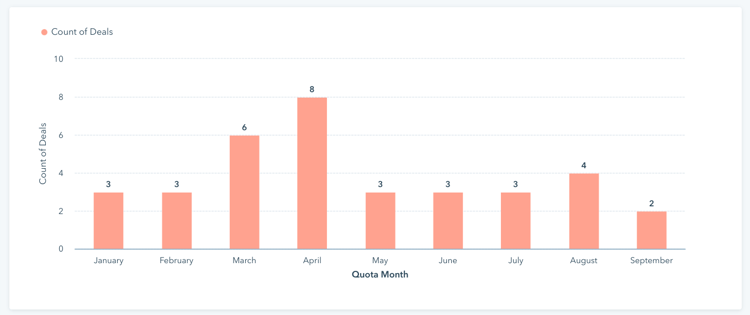
That’s an average of 3.9 appointments per month. And how have those appointments ended up so far? See below.
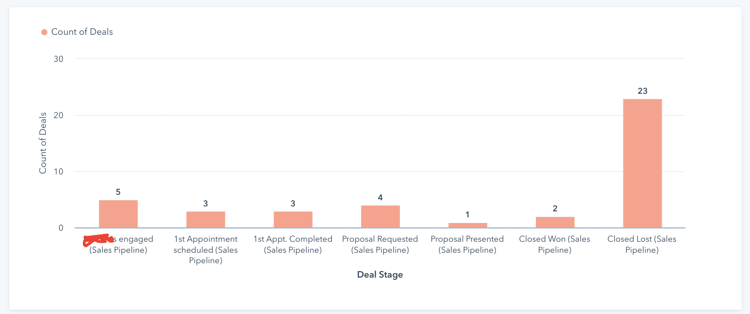
2 have converted into customers so far, 4 are in “Proposal Requested” and 1 in “Proposal Presented” stage. The majority are in closed-lost. More on the “closed-lost” group later.
And for a different MSP entirely, how many appointments are they getting on a monthly basis?
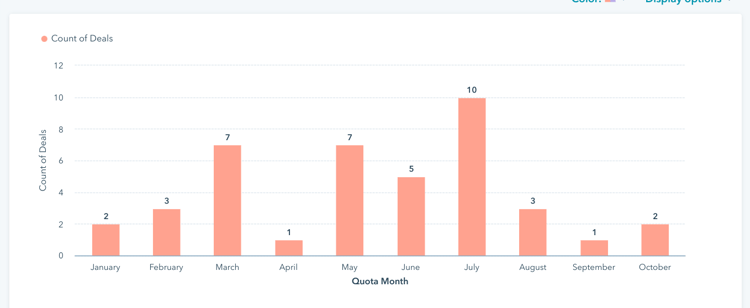
Each passing month contains a lot of stories worth hearing. Good decisions, bad ones, mistakes made, some great choices and many, many unlucky breaks. Lots of questions you probably have but this chapter isn't about our MSP partners, it's about how your MSP can connect with 4 or more Sales-Qualified Leads per month.
So let’s get right into it.
How would 4 appointments a month impact your MSP?
You’d get a few new customers. It would allow your MSP to plan ahead. It could enable you to recruit better people, retain the good ones you have. Maybe it would increase your MSP's valuation if that’s what you have in mind. This is an important step in the lead generation process.
But it’s not the entire answer to MSP lead generation headaches. Remember that many prospects are in a contract. Many are open to tirekicking but that’s about it. Why? Because something is wrong, they feel it and experience it with the current MSP, but it’s not enough to drop everything yet. Switching is a major decision that takes far more time and effort than a quick video call or appointment.
Bottomline? Don’t stop reading at chapter 3. The trust building happens in chapter four. Someone that’s an SQL today can be an Opportunity tomorrow because of chapter four.
Step 1 - Document Your Ideal Client Profile (ICP)
The ideal client profile is exactly how it sounds: the perfect customer for your MSP. That profile has almost certainly changed over the years.
Today, you have “A” clients, “B” clients and then the ones you want to fire. You know who I’m talking about. So aside from the geographic location, headcount range and even the industry. Focus on identifying the problems they are facing with the legacy MSP. What is the impact that is having on their business?
Interview your best customers and make that ideal client profile!
Step 2: Purchase & Configure an Outbound Sales System
We use HubSpot's "Sales Professional" version. There are many options out there that can do a decent job, too.
Whatever you use, it must reduce the friction in the SDR's daily activities; facilitate multi-channel outbound tactics; and finally, it must track a lot of KPIs along the way.
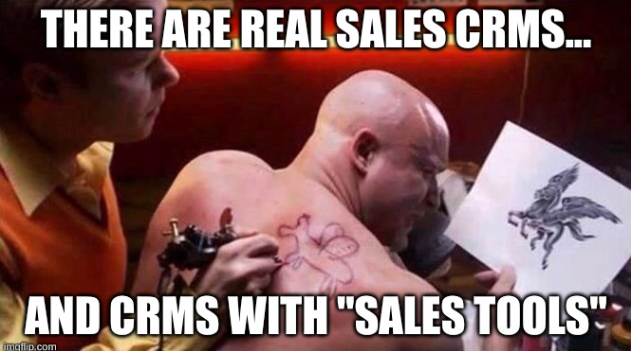
Think of it this way. You got your town sub shop that has pizza somewhere on the menu, and then there are pizzerias in Firenze, Italia, that only sell brick-oven pizza.
Who cares about getting brick-oven pizza for the Sales Rep you say!?
Well, wait a second, let’s take a step back. Cold-prospecting is arguably one of the hardest jobs on earth.
You (well maybe not you you, but many reading this guide) wouldn't last a week as an SDR. You know it’s true. Because most wouldn't handle the pressure, the constant rejection, not to mention the discipline required to dial every day.

There’s more to the job than cold-calling. It’s multi-channel now! Some prospects prefer to respond via e-mail or direct message on social media.
Therefore, SDRs need to not only dial and be comfortable with rejection, they also need to participate in social media, send hundreds of emails (got to be personalized, not some robotic crap) and add fresh new leads to the pipeline on a regular basis.
They also need to eat, sleep, laugh, and you know, try to stay positive and not burn out.
I’m getting stressed just writing about how hard this job is and so, for your MSP’s sake, help your salespeople by getting them a tool that was built to enable them, not to slow them down.
For example, your system must have some sales automation features to help reduce some of the workload.
Step 3: Prepare the Management System
The management system must answer several important questions including but not limited to the following:
How will your SDR’s performance be evaluated?
What will you expect from them in their first month, second month, and third month?
Who will do 1-to-1 coaching, how often per month, and how much time will each coaching session last?
If you hire multiple SDRs, what contests will you run and what about group training topics?
According to a survey by The Bridge Group of 406 B2B organizations, this is how the career paths often go.
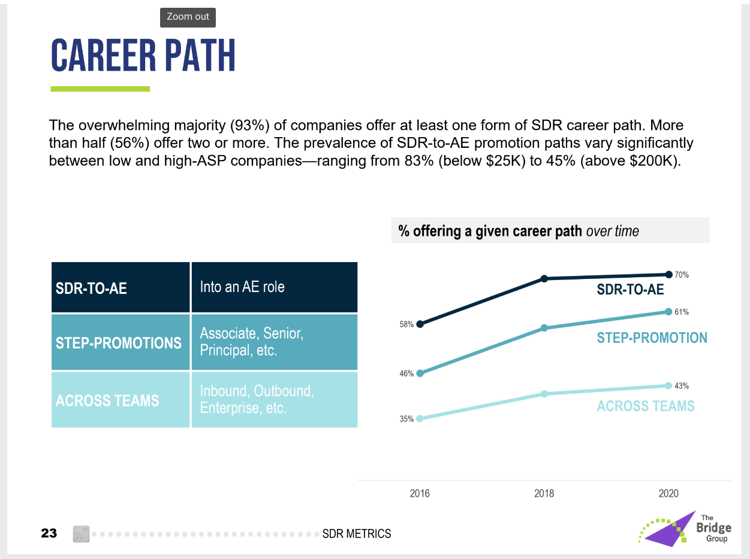
And one of my favorite thought-leaders on sales management is Mark Roberge. Harvard Business school professor and former Chief Revenue Officer for HubSpot.
Step 4: Onboard your Business Development Representative (BDR) or Full-Cycle Salesperson
Onboarding is its own process which of course means it requires documentation and continuous improvement.
It’s hard to crack onboarding from the start. Many SDRs are green to both sales and the IT industry. And not only are they green, they are about to get psychological punches in the face
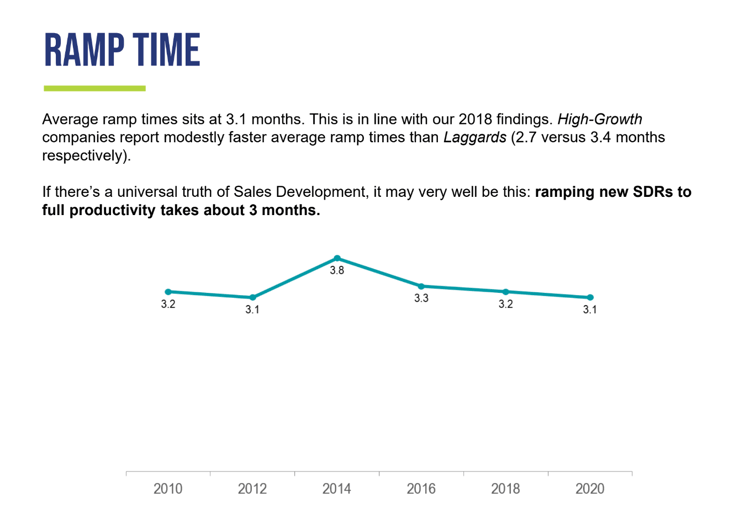
According to The Bridge Group survey, SDRs take an average of 3 months to ramp up. That’s about the same for our SDRs. And this happens when the onboarding process, sales system and management process is tried and true.
It has taken us a long time to get onboarding to a point where it produces consistent results. And we will have to constantly tweak it because this is a battle of inches, not miles.
Onboarding is beyond the scope of this guide, but here is a webinar with lots of tips and best-practices.
Step 5: Implement Outbound
This is where the rubber hits the road! It's time to implement outbound appointment setting!
Look, there's a lot to this. It takes grit, humility and patience to get right. In a nutshell, it requires dials (lots of them), emails and a few LinkedIn touches.
We've put together an MSP Appointment Setting playbook that you can find here if you want to get into the weeds.
Step 6: Track Outbound Results & Continuous Improvement
We have a dashboard that includes any reports. You need sales reporting. Your MSP needs the data to understand how the SDR is performing on specific parts of the process.
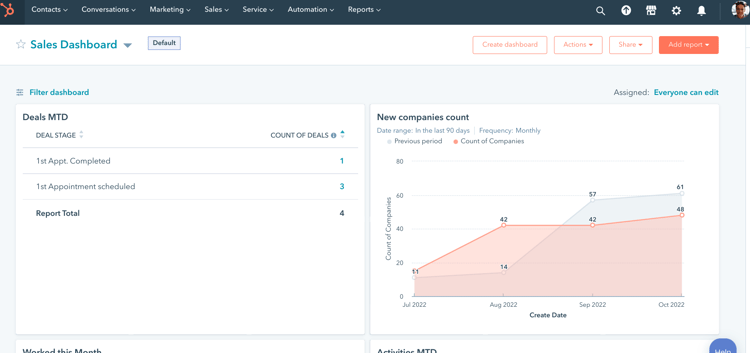
For example, one of my favorite reports is the Call Outcomes Report. It tracks how many conversations the SDR is having with decision-makers.
This may sound insane to some of you, but the average number of conversations per day is just 4.
That’s right, the vast majority of dials end up in voicemail, gatekeepers or no answers. It’s very frustrating but that is the nature of outbound.
Another great report is our Booking Conversion Report. It measures the percentage of connected calls that convert into an appointment. The average for us is 7%. It varies based on SDR experience level, time of year (December sucks) and the quality of the leads.
Bottomline is that appointments and dial tracking alone is inadequate. Don’t kid yourself. An SDR with great potential can be generating zilch. They may be dialing a lot but that alone doesn’t mean anything. It’s your job to figure out what’s stopping him or her from reaching quota and different data points will empower you to find the actual obstacles.
2024 Updates
After doing this a few years now we've developed an Outbound Sales Risk Assessment (OSRA) and one section is dedicated to "Lead Capture."

MSPs need to be concerned with all 9 gray boxes in order to get enough appointments with ICPs. However, let's say you can't afford an SDR/BDR yet and your only weapon to hunt with is the phone in your hand. If that were your situation, then BEFORE you work on a cold-call script for yourself, I strongly suggest you determine your wedge solution, lead magnet and to gather a few good client stories (situation, problem, impactct).
I would never ever ever do cold-calling brand new leads for IT Support/Managed IT!
Re-work your cold-call strategy to focus on the side-door MRR solutions that can get you in the door faster and to build your reputation as a trusted advisor (not a computer janitor) early on.
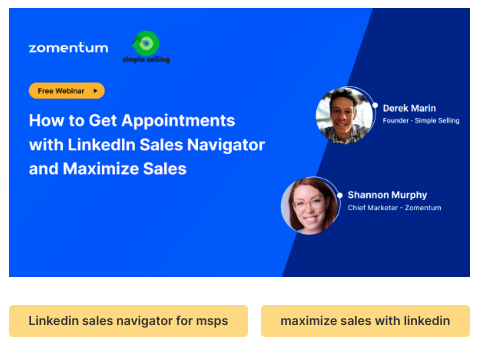
Zomentum Blog
How to Get Appointments with LinkedIn Sales Navigator and Maximize Sales | Webinar Summary
Chapter 4
Nurturing SQLs
Here’s the unfortunate truth about outbound. Most potential switchers are not in the buying cycle when we interrupt their lunch.
They may need 9, 12 or even 18 months before seriously considering an alternative.
Below is a snapshot of the outcomes of outbound prospecting during a year. Note the green line.
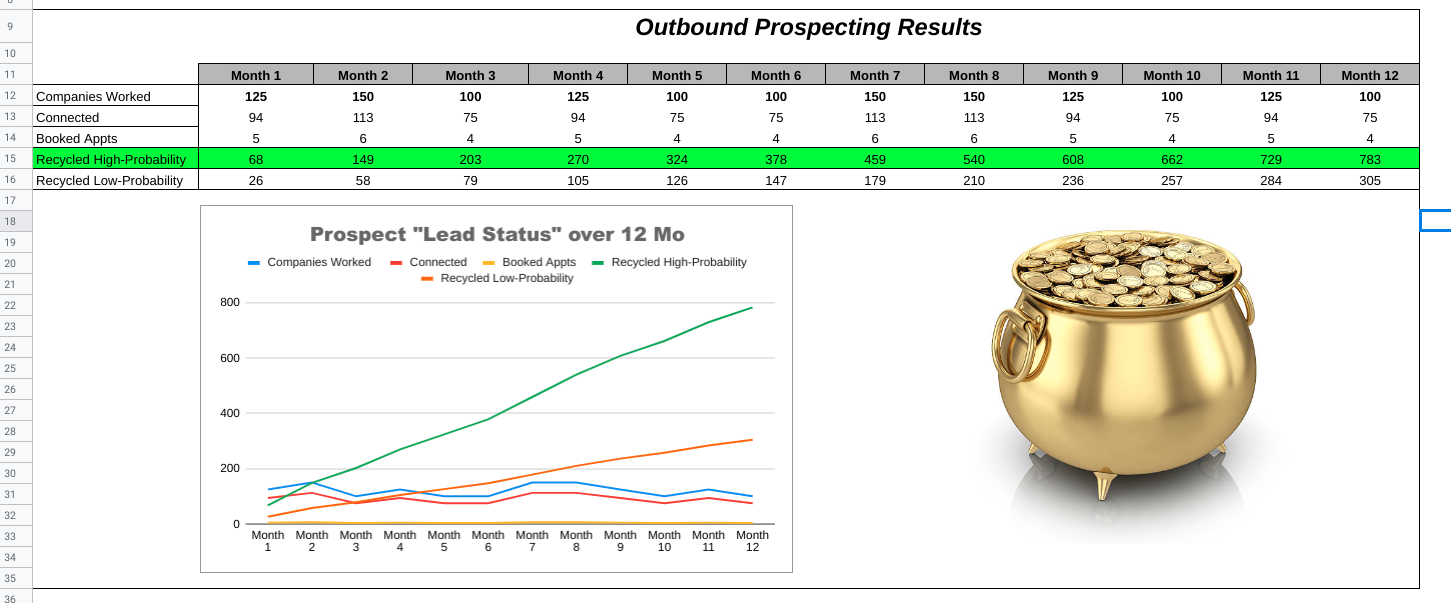
The green represents the “Recycled-High Probability” segment of prospects for an MSP doing outbound. These are qualified prospects who weren’t in a buying mode when the SDR cold-called but who responded honestly when asked about future renewal dates with the incumbent.
As we can see, this is the largest pile that every CRM accumulates during the outbound process. Therefore, the most MRR potential is with that segment, not with the Booked segment.
The Most Common Mistakes with MSP Marketing Services
The most common mistake I’ve seen when it comes to MSP marketing is the flawless creation of generic IT content.

Is it any wonder this stuff generates nothing in return?
Of course, not!
The second most common mistake is the random acts of marketing syndrome.

Unfortunately, inconsistency often happens because MSPs typically lack a Marketing Manager or a vendor to do this. The MSP does marketing whenever they get inspired and so it’s not a habit, it’s a lucky one-off event.
Is it any wonder that prospects don’t call back? Nope.
Is it any wonder that we get out of shape if we don’t go to the gym consistently? Also “no.”
So let’s fix this.
Step 1: Segment your SQLs into 2 Buckets
The benefit of outbound prospecting isn’t just “setting appointments,” it’s gathering market intelligence.
A cold-call can help an MSP determine if a prospect that qualifies on paper is in fact a potential switcher.
For example, here are two different types of prospect cold-call objections.
Prospect A: “No thank you, we have another IT provider already. Not interested in meeting you now.”
Prospect B: “No, thank you. Our MSP is fantastic. Been with them for 3 years. They meet with us quarterly. No chance we would make a change.”
One conversation doesn’t necessarily mean a prospect is “good” or “bad.” Good listening and follow up by the SDR can uncover deeper truths as to the long term potential.
But generally speaking, when a prospect speaks in vague and generic terms about the incumbent, it can mean they are somewhat satisfied today, whereas when they are detailed and describe themselves as “very happy,” then we know the switch is stacked against us.
This is where segmentation comes in. After the cold-call is done, prospects that get kicked back to marketing ought to be categorized in the CRM as either a “high probability” or “low probability” segment.
By tracking the status of each prospect into these 2 groups, the marketing team can segment the sending of marketing messages, and therefore get better results.
Step 2: Build a Repeatable Content Creation System
There is no single “way” to get content created within an MSP. Each MSP is structured differently, with different personality types, cultures, strengths and weaknesses.
But here are some suggestions on how to get started with insourced content creation.
Hire Someone to Oversee the System
One person should “own” the marketing program. They should be creating content every week. Because the alternative is that the MSP President, VP of Sales, or someone else with another full-time job “tries” to find time for this and they never do.
Leverage Support Tickets Your Team Closes
What would happen if every time a support ticket was closed that they bcc’ed the marketing team? Do you think the marketing department would ever run out of content ideas?
Nope!
Now, I’m not suggesting we flood marketer’s with every single help desk ticket. However, I am saying that some tickets are interesting, repetitive and highly valuable for prospects to see your answers to.
Start listening and talking to yourself out loud
You know how prospects and customers sometimes ask the same questions about your services and you go into a long winded conversation to answer it?
Well, you’re not alone. And so the point is that these questions are probably good ones to answer on your website and you can efficiently collect and curate these by leveraging your smartphone!
That’s right. Your phone recording app is a nifty tool you can open at a moment’s notice and record the question and the answer.
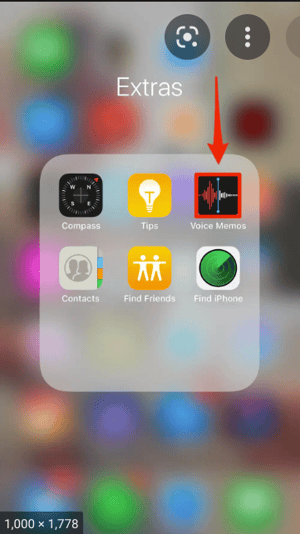
And after you’re finished recording you just got to share it with your content team! You’ll be amazed at how you’ll be inspired at different times. You’ll also be impressed with how you can turn into a content creation machine by using this tactic. Give it a try.
Get Buy-In from your Services and Sales Team
Remember your Services and Sales teammates are the subject-matter experts that are crucial for this process to work. And in order to get them to participate they need three things: to know how, what and why their participation matters.
If someone says “We don’t have time for that” then we all know what that actually means. It means they don’t see the value. There’s no point.
So please skip the email announcement that says “hey you must participate in marketing” and instead spend a few hours to give them the backstory. They need more time to understand why you need them, how they will be part of this and what specifically they will need to contribute.
Learn how each Employee Best Communicates
Well, here’s something you are probably already concerned about.
Not every employee is great on camera!
And not every employee likes to write articles, either.
So the simple fix is to ask and verify what each contributor prefers. Ask each person how they want to participate and then meet with them individually to validate. Customizing how each person prefers to communicate is appreciated and will get the best results.
Ready to Get Serious About MSP Lead Generation Solutions?
Schedule a Session to see if we're the right fit for your MSP
